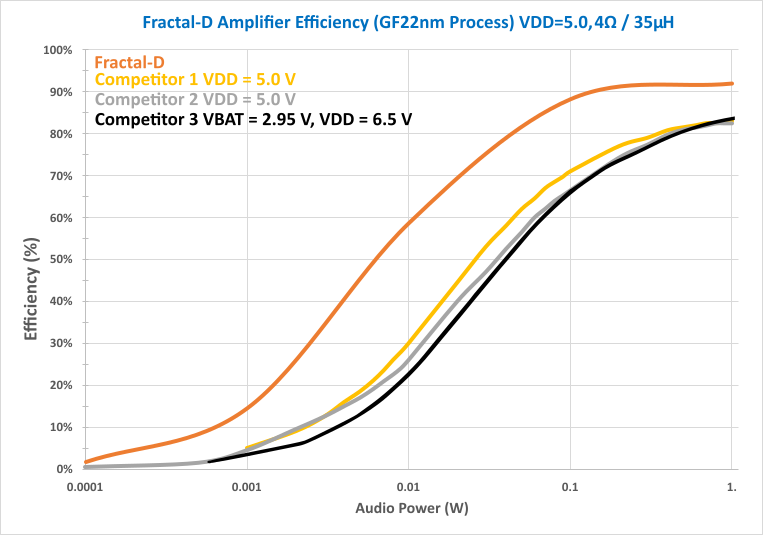Save power, improve performance, and program for a wide range of products.
Description
SiliconIntervention applies an architectural approach to solving the real-world problem of maximizing efficiency in Class-D drivers over a wide range of power levels. This architectural approach is the basis for products with a self-determining ability to maximize efficiency over a wide range of operations.
FRACTAL-D based silicon products can leverage the advances already established using SiliconIntervention’s half-buck techniques and extend those gains automatically over a wide operating spectrum.
FRACTAL-D based products utilize conventional CMOS processes, do not call for non-volatile memory, and do not demand CPU/DSP processing or unique control signals/pins.
FRACTAL-D is smart enough to figure out how to apply maximum efficiency to the task at hand—in real time.
FRACTAL-D IP is another example of a growing IP product portfolio based on the “New AnalogTM”: a groundbreaking approach to sensor domain signal processing using next generation advanced analog and mixed signal design techniques.
Audio Fractal-D: high efficiencies for audio applications.
A large increase in driver efficiency with the advantage that it:
- Needs no regulator or associated components.
- Removes the need to change the driving digital signal gain
- Removes the need for any envelope prediction
- Offers optional feedback to create high quality output
- Achieves more than the efficiency gain that a 100% efficient external buck regulator would provide.
Save power, save space, save complexity in audio products.
Based on advanced sigma-delta methods that perform a precise PCM to PWM conversion, the FRACTAL-D core is a scriptable HDL design achieving good performance prior to feedback. Digital feedback with included ADC meets the most demanding applications.
An agile solution for high efficiency over a range of applications.
- Has <10 µV A-weighted noise
- Has improved power supply rejection
- Has digital feedback so PSRR is good
- Utilizes adaptive FET drivers, saving power
Overview
Typical Class-D amplifiers are generally tuned to give the highest efficiency when outputting large power levels. For example, a typical amplifier may have a prime tuning point at or around 1 W, primarily driven by the delivery of a low distortion output into a 4-ohm speaker load at a typical Li-Po battery supply (3.3 to 4.2 V). Efficiencies of 80 to 90% at 1 W are achievable with standard ‘H-bridge’ Class-D amplifiers.
We have seen that these amplifiers have a rather low efficiency at lower power levels (typically 30-40% at 10 mW). A new type of bridge configuration included in FRACTAL-D improves the efficiency at these lower power levels to ≈60% at 10 mW while maintaining the ≈90% efficiency at 1 W.
| Specification | Value | Notes |
| BridgeSupply | 5 V or 8 V | 22 nm with 5 V devices -or- 55 nm with HV devices |
| Switching Rate | 350-400 | kHz |
| THD | > 90 db < 0.004% | 4/8/32 Ω 15-30 µH Analog Closed Loop or Digital Open Loop |
| Noise Level Vrms (A-wt) | < 3[1] or < 8 | 3 µV A-wt 1 V RMS 5 V or lower, 8 µV A-wt 5 V RMS, 8 V |
| Noise Level dBR (A-wt) | < -112 | Using SI advanced analog control loop -114 dB @ 1 Vrms FS |
| Efficiency at 1% Max Power | 62% | Exceeds typical industry standards of 45% |

Figure 1 shows the benefit of FRACTAL-D over some typical 1 W Class-D amplifiers on the market today. Note the >60% efficiency at 1% power compared to currently available solutions at <40%.
Availability
FRACTAL-D is available as IP together with expert services for mapping into CMOS process nodes of choice.